|
|
| Alphabetical Index About MathWorld 13,172 entries Created, developed, and nurtured by Eric Weissteinat Wolfram Research | Geometry > Plane Geometry > Circles > Geometry > Curves > Plane Curves > Conic Sections > Geometry > Curves > Plane Curves > Polar Curves > Circle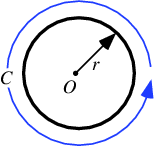 A circle is the set of points in a plane that are equidistant from a given point A circle has the maximum possible area for a given perimeter, and the minimum possible perimeter for a given area. The perimeter
This can be computed using calculus using the formula for arc length in polar coordinates,
but since
The circumference-to-diameter ratio 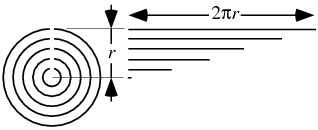 Knowing
This derivation was first recorded by Archimedes in Measurement of a Circle (ca. 225 BC). 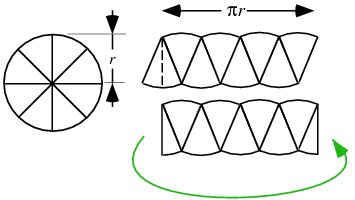 If the circle is instead cut into wedges, as the number of wedges increases to infinity, a rectangle results, so
From calculus, the area follows immediately from the formula
again using polar coordinates. A circle can also be viewed as the limiting case of a regular polygon with inradius
and the area as
which are equivalently since the radii Unfortunately, geometers and topologists adopt incompatible conventions for the meaning of " The circle is a conic section obtained by the intersection of a cone with a plane perpendicular to the cone's symmetry axis. It is also a Lissajous curve. A circle is the degenerate case of an ellipse with equal semimajor and semiminor axes (i.e., with eccentricity 0). The interior of a circle is called a disk. The generalization of a circle to three dimensions is called a sphere, and to The region of intersection of two circles is called a lens. The region of intersection of three symmetrically placed circles (as in a Venn diagram), in the special case of the center of each being located at the intersection of the other two, is called a Reuleaux triangle. In Cartesian coordinates, the equation of a circle of radius
In pedal coordinates with the pedal point at the center, the equation is
The circle having
The parametric equations for a circle of radius
The circle can also be parameterized by the rational functions
but an elliptic curve cannot. 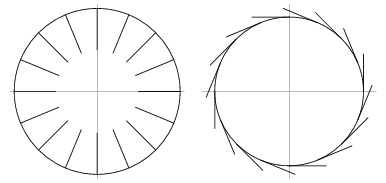 The plots above show a sequence of normal and tangent vectors for the circle. The arc length
The Cesàro equation is
In polar coordinates, the equation of the circle has a particularly simple form.
is a circle of radius
is circle of radius
is a circle of radius The equation of a circle passing through the three points
The center and radius of this circle can be identified by assigning coefficients of a quadratic curve
where
The center can then be identified as
and the radius as
where
Four or more points which lie on a circle are said to be concyclic. Three points are trivially concyclic since three noncollinear points determine a circle. In trilinear coordinates, every circle has an equation of the form
with The center
(Kimberling 1998, p. 222). In exact trilinear coordinates
(Kimberling 1998, p. 222). An equation for the trilinear circle of radius Beyer, W. H. CRC Standard Mathematical Tables, 28th ed. Boca Raton, FL: CRC Press, pp. 125 and 197, 1987. Casey, J. "The Circle." Ch. 3 in A Treatise on the Analytical Geometry of the Point, Line, Circle, and Conic Sections, Containing an Account of Its Most Recent Extensions, with Numerous Examples, 2nd ed., rev. enl. Dublin: Hodges, Figgis, & Co., pp. 96-150, 1893. Coolidge, J. L. A Treatise on the Geometry of the Circle and Sphere. New York: Chelsea, 1971. Courant, R. and Robbins, H. What Is Mathematics?: An Elementary Approach to Ideas and Methods, 2nd ed. Oxford, England: Oxford University Press, pp. 74-75, 1996. Coxeter, H. S. M. Regular Polytopes, 3rd ed. New York: Dover, 1973. Coxeter, H. S. M. and Greitzer, S. L. "Some Properties of the Circle." Ch. 2 in Geometry Revisited. Washington, DC: Math. Assoc. Amer., pp. 27-50, 1967. Dunham, W. "Archimedes' Determination of Circular Area." Ch. 4 in Journey through Genius: The Great Theorems of Mathematics. New York: Wiley, pp. 84-112, 1990. Eppstein, D. "Circles and Spheres." http://www.ics.uci.edu/~eppstein/junkyard/sphere.html. Hilbert, D. and Cohn-Vossen, S. Geometry and the Imagination. New York: Chelsea, p. 1, 1999. Kern, W. F. and Bland, J. R. Solid Mensuration with Proofs, 2nd ed. New York: Wiley, p. 3, 1948. Kimberling, C. "Triangle Centers and Central Triangles." Congr. Numer. 129, 1-295, 1998. Lachlan, R. "The Circle." Ch. 10 in An Elementary Treatise on Modern Pure Geometry. London: Macmillian, pp. 148-173, 1893. Lawrence, J. D. A Catalog of Special Plane Curves. New York: Dover, pp. 65-66, 1972. MacTutor History of Mathematics Archive. "Circle." http://www-groups.dcs.st-and.ac.uk/~history/Curves/Circle.html. Pappas, T. "Infinity & the Circle" and "Japanese Calculus." The Joy of Mathematics. San Carlos, CA: Wide World Publ./Tetra, pp. 68 and 139, 1989. Pedoe, D. Circles: A Mathematical View, rev. ed. Washington, DC: Math. Assoc. Amer., 1995. Yates, R. C. "The Circle." A Handbook on Curves and Their Properties. Ann Arbor, MI: J. W. Edwards, pp. 21-25, 1952. CITE THIS AS:Weisstein, Eric W. "Circle." From MathWorld--A Wolfram Web Resource. http://mathworld.wolfram.com/Circle.html Wolfram Web Resources
| THINGS TO TRY: 
|









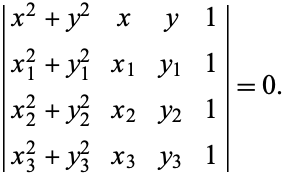

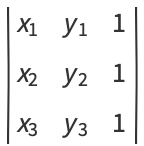
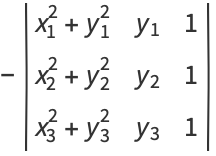
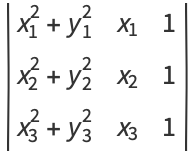
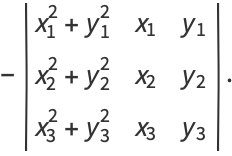

 circle
circle



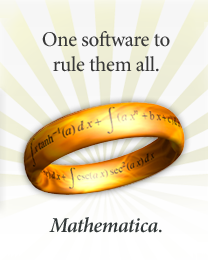














 765
765











 被折叠的 条评论
为什么被折叠?
被折叠的 条评论
为什么被折叠?








